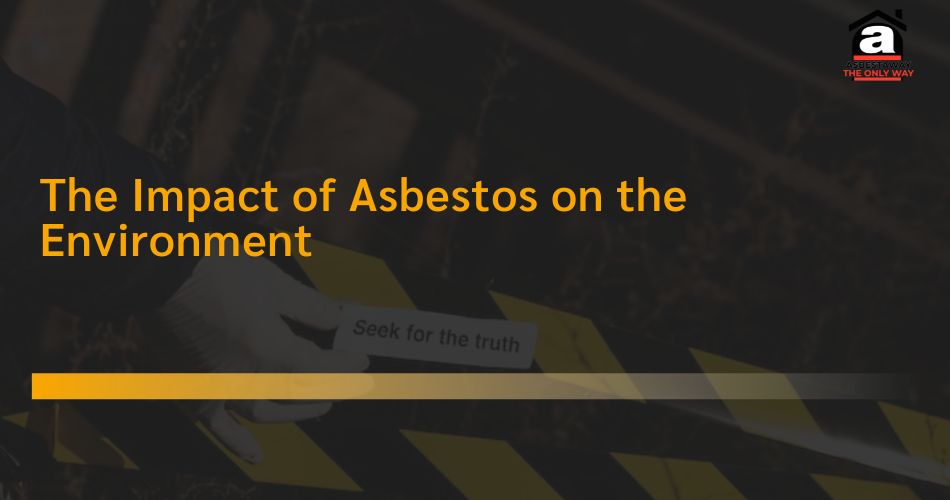Asbestos refers to a group of naturally occurring minerals composed of thin, needle-like fibres. Due to its heat resistance and durability, asbestos was widely used in past in various industries, including construction, automotive manufacturing and more. Asbestos was used in many different things because it was strong and could handle heat well. It was used in building materials like roofing and insulation, in car parts, and even in clothes and blankets. Asbestos was once popular in building and manufacturing. People liked it because it was strong and could resist high temperatures. Similarly, its heat-resistant properties made it ideal for automotive brakes and clutch parts. Asbestos was also valued in shipbuilding for its fireproofing capabilities. Let’s explore in this blog about impact of asbestos on the environment, asbestos management and mitigation as well as its Cleanup and Remediation.
Environmental Impact of Asbestos
-
Air Pollution
Airborne asbestos fibres pose a serious health risk when materials containing asbestos are disturbed or degrade over time. During activities such as demolition or renovation of older buildings, asbestos fibres can become airborne and easily inhaled. These microscopic fibres, once when enters in the lungs, can lead to severe health issues such as asbestosis, lung cancer, and mesothelioma. Symptoms of these diseases may appear after years, making prevention of exposure through proper handling and mitigation important.
-
Water Contamination
Asbestos can contaminate water sources when asbestos-containing materials degrade and release fibres that enter nearby water bodies. This can occur through runoff from asbestos-containing roofs, pipes, or industrial waste. Once in water, asbestos fibres can pose a risk to aquatic organisms and, potentially, humans through consumption of contaminated water or seafood. Although regulations and monitoring help reduce the risk of asbestos entering water supplies, the persistence of these fibres in aquatic environments remains a concern.
-
Soil Contamination
Asbestos fibres can also contaminate soil through various pathways, such as improper disposal of asbestos-containing materials or the breakdown of older structures. Once in the soil, these fibres can persist for extended periods, posing a risk to anyone who comes into contact with contaminated soil. During construction or excavation activities, disturbed asbestos-contaminated soil can release fibres into the air, increasing the risk of exposure. Moreover, asbestos in soil can affect plant growth and wildlife in the area, potentially disrupting local ecosystems.
Asbestos Management and Mitigation
-
Safe Handling and Removal Practices
Safe handling and removal practices is important in the management of asbestos. The process must begin with identifying asbestos-containing materials thorough inspection and testing. Protective gear should be used ensuring the safety of workers involved in asbestos removal. This includes specialized respirators or masks, disposable coveralls, gloves, and eye protection. These protective measures are designed to minimize direct contact with asbestos fibres and prevent inhalation. Furthermore, specialized techniques should be used for the safe removal and disposal of asbestos.
-
Role of Professional Asbestos Removal Services
When it comes to managing asbestos in buildings, relying on professional asbestos removal services is important. These experts are trained to assess asbestos risks, execute safe removal procedures, and ensure compliance with regulatory standards. Their role extends beyond only removal; it includes thorough site evaluation, containment measures to prevent fibre release, and careful cleanup to eliminate any residual asbestos. Choosing certified professionals not only minimizes health risks but also provides peace of mind that asbestos issues are addressed effectively and responsibly.
-
Community Awareness and Education
Community awareness and education are fundamental pillars in the prevention of asbestos-related health hazards. This involves awareness about proactive efforts to inform the public about the risks associated with asbestos exposure, common sources of asbestos in homes and workplaces, and the importance of regular inspections in older buildings. By promoting awareness campaigns, workshops, and educational materials, communities can empower individuals to recognize asbestos hazards and take appropriate precautions.
Environmental Cleanup and Remediation
-
Cleanup of Contaminated Sites:
Cleanup efforts typically involve a range of specialized techniques and technologies customised to the specific contaminants present. These may include physical methods like excavation and soil washing, chemical treatments such as oxidation or neutralization, and biological approaches like bioremediation using microorganisms to break down pollutants. Each contaminated site presents unique challenges, requiring careful assessment and planning to ensure effective remediation. The goal is to mitigate risks to human health and ecosystems.
-
Innovative Technologies in Asbestos Remediation:
Innovative technologies in asbestos remediation focus on minimizing these risks through advanced removal techniques that reduce fibre release during demolition or renovation projects. Methods include wetting asbestos-containing materials to prevent fibre dispersion, using specialized vacuums and HEPA filters to capture fibres, and employing encapsulation techniques that seal asbestos in place. Moreover, technological advancements have improved asbestos detection methods, allowing for more accurate identification of asbestos-containing materials in buildings.
-
Long-Term Environmental Monitoring:
Long-term monitoring serves multiple purposes: it verifies the effectiveness of cleanup actions, detects any potential recontamination or residual pollutants, and provides early warning of emerging environmental concerns. Monitoring programs are typically designed with input from environmental scientists and regulatory agencies to establish baseline conditions and identify acceptable levels of contaminants post-remediation. Advanced monitoring technologies, such as remote sensing, automated sampling systems, and real-time data analysis, enable continuous assessment of environmental conditions without interrupting daily operations.
Asbestaway Your Trusted Partner For Safely Asbestos Removal
Asbestaway is your trusted partner for safe asbestos removal across Australia. With our strong focus on professionalism and strict compliance with asbestos regulations, we’ve earned a trusted reputation in the industry. Our experienced team has over 40 years of combined expertise and specializes in carefully removing asbestos from homes and businesses through controlled demolition and secure extraction methods. At Asbestaway, safety is our top priority. We ensure all necessary protocols, licenses, and certifications are strictly followed to protect both people and properties. Our mission is straightforward: to provide efficient and reliable asbestos removal that keeps you safe. Trust Asbestaway for safe and efficient asbestos removal.
Conclusion
The extensive use of asbestos in the past has had a significant impact on our environment, affecting the quality of air, water, and soil. When materials containing asbestos break down or are disturbed during activities like demolition, tiny asbestos fibres can be released into the air. Breathing in these airborne fibres can lead to serious health problems such as asbestosis, lung cancer, and mesothelioma. Additionally, asbestos that finds its way into water sources or soil can harm aquatic life and disrupt the growth of plants, which can upset the balance of local ecosystems. For effective asbestos management we must spread awareness and follow proactive steps. Safe handling and professional removal services are important to reduce health risks from exposure. Community education is key in identifying and dealing with asbestos dangers at home and work. Advanced technologies and Innovative techniques should be used on both asbestos removal and preventing fibre release.

